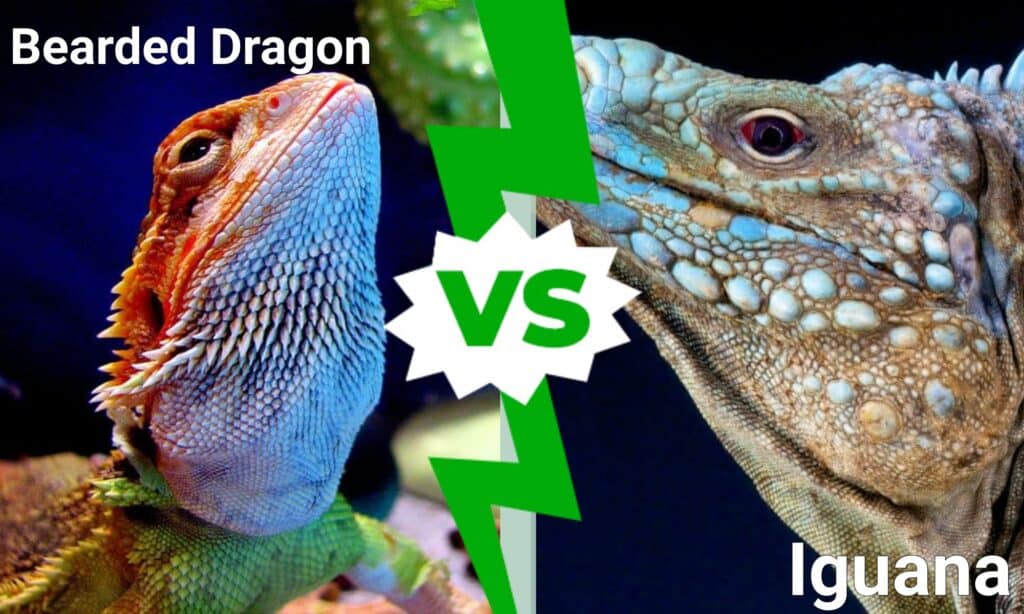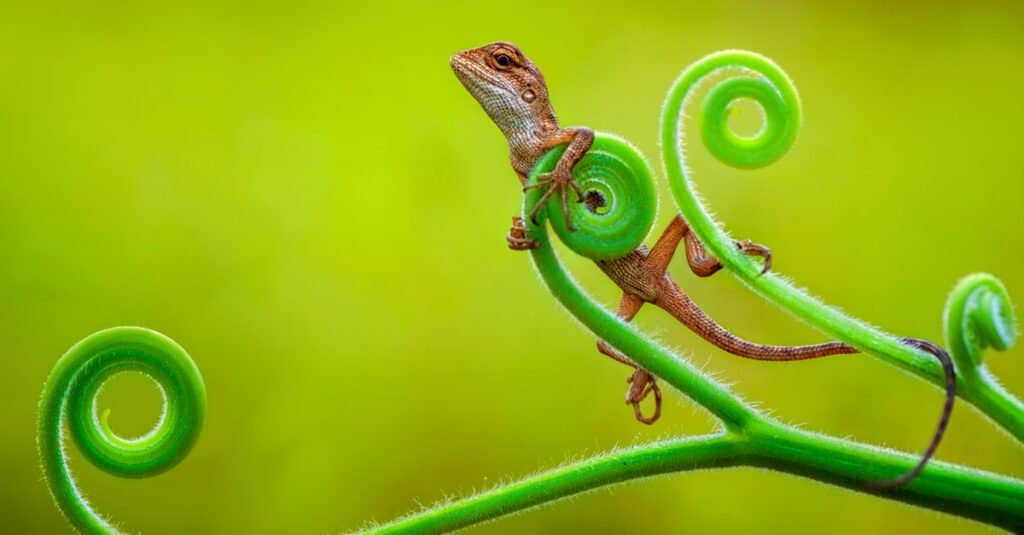
With a passing glance, you may not be able to tell the difference between an iguana and a bearded dragon. Some animals are hard to distinguish between but there are some key differences between these reptiles.
These two lizards have significant size differences, with iguanas tending to grow much larger. They also prefer different diets, so you definitely wouldn’t want to confuse the two. Both iguanas and bearded dragons can make a really excellent pet if you know how to care for them. Let’s take a closer look at what they have in common and what sets them apart.
Iguanas:
Size: 5-6 feet and 6-17 lbs
Diet: Herbivores
Teeth: Pleurodont
Tail: Autotomous
Morphology: They have green or brown colored scales with bands around them, along with a dewlap and frill along their backs. Iguanas also have sharp tails and teeth.
Bearded Dragons:
Size: 16-24 inches and 11-19 oz
Diet: Omnivores
Teeth: Acrodont
Tail: Not Autotomous
Morphology: They have red, yellow, and brown coloration. Their head is triangular, and they can have some light striping. They also have small, sharp teeth.
Bearded Dragon vs Iguana: Size Differences
Iguanas grow significantly larger than bearded dragons do, and that means when you look at the two lizards side by side, it’s easier to distinguish between them than you might think. Iguanas can grow up to six feet in length from the tip of their tail to the top of their snout.
Bearded dragons are much smaller in comparison, only growing to two feet at their longest. They weigh only about 19 ounces when at their heaviest, which is a sharp contrast to the iguana, which can be between six to 17 lbs depending on their diet and activity levels.
Bearded Dragon vs Iguana: Diet Differences

Bearded dragons are omnivores, while iguanas are herbivores.
©iStock.com/Mladich
When comparing the diet of these two lizard species, you may be shocked to learn they are entirely different. While bearded dragons are omnivores, meaning they eat both meat and plants, iguanas are strictly herbivores and only eat plants.
The Journal of Herpetology states that iguanas primarily eat vegetation material such as leaves, and they swallow fruits, vegetables, and leaves whole without chewing, despite having teeth. Iguanas can also eat flowers when they want to, though their diet consists mainly of leaves.
For bearded dragons, their diet in the wild is similar to that in captivity, with some species specific preferences. This lizard mostly consumes arthropods, as stated in the publication Zoo Biology. This means that they eat small invertebrate insects like crickets and various worms. Since bearded dragons eat both insects and plants, leaves, vegetables and fruits are suitable for their diet.
Addressing Water Requirements
They don’t drink water as other animals do. Instead, they absorb it mainly from the foods they eat and the baths they get when they swim.
Both lizards need to be misted daily and bathed regularly when in captivity. This is especially important since bearded dragons are far less likely to try eating fruits and vegetables when caged. Iguanas will drink from a water bowl, but it’s still essential to help monitor their intake just in case.
Bearded dragons should be misted daily and bathed about once a week. Iguanas benefit from a daily misting or a daily bath to help with their scales.
Bearded Dragon vs Iguana: Teeth Differences

Bearded dragons have acrodont teeth, and iguanas have pleurodont teeth.
©Guillermo Guerao Serra/Shutterstock.com
Both bearded dragons and iguanas have teeth, which is surprising to many. Even though iguanas are omnivores, they still possess teeth. They have what is known as pleurodont teeth, which can be replaced easily and are all the same size.
Their teeth can resemble a serrated knife, which is perfect for tearing up the plants they need to survive.
Bearded dragons have acrodont teeth, a permanent set of small and spiky teeth. This means that they can give a sharp bite when they need to. They’re able to latch on very tightly when threatened.
One of the more significant differences in these types of teeth is that once acrodont teeth grow in, they are not replaced with adult teeth. They stay, hopefully, throughout a bearded dragon’s life.
Bearded Dragon vs Iguana: Tail Differences

If iguana’s tails are broken off they can grow back, but that is not the case for bearded dragons.
©Hadrani Hasan/Shutterstock.com
Some lizards have what is referred to as autonomous tails, which can be detached when grabbed onto and grow back. This is helpful when a predator catches a lizard by the tail and they can still escape. Iguanas have autonomous tails.
Bearded dragons do not have autonomous tails, so if their tail falls off or is bitten off, it will not grow back. Iguanas use their tails as weapons, like a whip, which is part of the reason it is lucky their tails grow back. They’re more likely to be thrown into a predator’s face.
Bearded Dragon vs Iguana: Morphology Differences
Morphology is the evolution of appearance and physical characteristics over time. Lizards have evolved to achieve different appearances and traits, and breeders will also purposefully breed them in specific ways to have purposeful colorations.
Iguanas typically come in greens and browns, making them better blend into the environment. They do not change color but can be banded. Bands are like thick stripes that wrap around their backs or tails.
Bearded dragons can change colors, and it usually depends on their mood. They can darken or lighten when scared or ill, which changes their colors against backdrops. Their beards, or the scales under their chins, can change colors when frightened or angry.
When it comes to these gorgeous lizards, it’s easy to see why the average person could be confused initially. But overall, these five key differences can turn anyone into a budding herpetologist.
On a final note, iguanas tend to freeze up in the cold. This results in them falling out of trees in Miami in Florida every year, which can be startling and hysterical at the same time.
The photo featured at the top of this post is © Serhii Brovko/Shutterstock.com
Thank you for reading! Have some feedback for us? Contact the AZ Animals editorial team.






